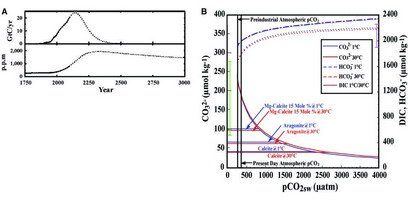
U.S. Dept. of Commerce / NOAA / OAR / PMEL / Publications
Fig. 1. (A) Atmospheric CO![]() emission scenario and concentrations based on the Los Alamos National Laboratory general circulation model after Caldeira and Wickett [Caldeira and Wickett, 2003]. Gt, gigatons. (B) Relation between the concentrations of carbonate species in surface waters at constant salinity and TA for surface waters spanning the approximate range of temperatures observed in the oceans as a function of the surface ocean pCO
emission scenario and concentrations based on the Los Alamos National Laboratory general circulation model after Caldeira and Wickett [Caldeira and Wickett, 2003]. Gt, gigatons. (B) Relation between the concentrations of carbonate species in surface waters at constant salinity and TA for surface waters spanning the approximate range of temperatures observed in the oceans as a function of the surface ocean pCO![]() in
in ![]() atm. The solid vertical light green line shows the range of carbonate ion concentrations observed in the present-day oceans, and the solid vertical magenta line shows the range of dissolved inorganic carbon concentrations. The three sets of parallel horizontal lines show the equilibrium carbonate ion concentrations for magnesian calcite, aragonite, and calcite saturation, respectively.
atm. The solid vertical light green line shows the range of carbonate ion concentrations observed in the present-day oceans, and the solid vertical magenta line shows the range of dissolved inorganic carbon concentrations. The three sets of parallel horizontal lines show the equilibrium carbonate ion concentrations for magnesian calcite, aragonite, and calcite saturation, respectively.
Fig. 2. Distribution of (A) aragonite and (B) calcite saturation depth (![]() = 1) in the global oceans. The pressure effect on the solubility is estimated from the equation of Mucci [Mucci, 1983] that includes the adjustments to the constants recommended by Millero [Millero, 1995]. The level at which aragonite and calcite are in thermodynamic equilibrium is known as the saturation depth. When the degree of saturation,
= 1) in the global oceans. The pressure effect on the solubility is estimated from the equation of Mucci [Mucci, 1983] that includes the adjustments to the constants recommended by Millero [Millero, 1995]. The level at which aragonite and calcite are in thermodynamic equilibrium is known as the saturation depth. When the degree of saturation, ![]() , is greater than 1, seawater is supersaturated with aragonite and calcite; conversely, seawater is undersaturated with respect to these minerals when
, is greater than 1, seawater is supersaturated with aragonite and calcite; conversely, seawater is undersaturated with respect to these minerals when ![]() < 1. This depth is significantly shallower for aragonite than for calcite, because aragonite is more soluble in seawater than calcite.
< 1. This depth is significantly shallower for aragonite than for calcite, because aragonite is more soluble in seawater than calcite.
Fig. 3. Vertical distributions of anthropogenic CO![]() concentrations in
concentrations in ![]() mol kg
mol kg![]() and the supersaturation/undersaturation horizons for aragonite and calcite along north-south transects in the (A) Atlantic, (B) Pacific, and (C) Indian Oceans.
and the supersaturation/undersaturation horizons for aragonite and calcite along north-south transects in the (A) Atlantic, (B) Pacific, and (C) Indian Oceans.
Fig. 4. In situ CaCO![]() dissolution rates plotted as a function of depth in the three major ocean basins.
dissolution rates plotted as a function of depth in the three major ocean basins.
Fig. 5. Schematic diagram of the CaCO![]() budget for the global oceans. The values are in Pg of CaCO
budget for the global oceans. The values are in Pg of CaCO![]() C year
C year![]() .
.
Table 1. Sediment trap particulate CaCO![]() dissolution fluxes in the Pacific Ocean. The difference between the mean carbonate flux in the upper trap and the lower trap defines the dissolution flux. In all but one of the deepwater cases, the CaCO
dissolution fluxes in the Pacific Ocean. The difference between the mean carbonate flux in the upper trap and the lower trap defines the dissolution flux. In all but one of the deepwater cases, the CaCO![]() flux collected in the midwater trap is higher than the carbonate flux collected in the deepwater trap. The dissolution rates are derived from the differences in CaCO
flux collected in the midwater trap is higher than the carbonate flux collected in the deepwater trap. The dissolution rates are derived from the differences in CaCO![]() sediment trap fluxes between the upper and lower sediment traps divided by the depth range between the traps.
sediment trap fluxes between the upper and lower sediment traps divided by the depth range between the traps.
Return to Abstract